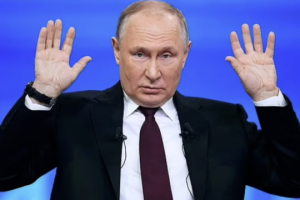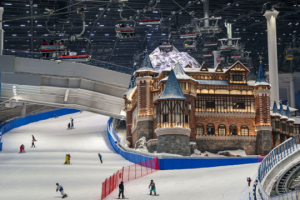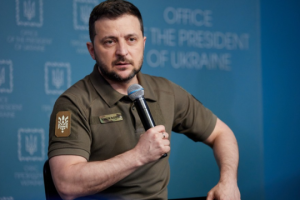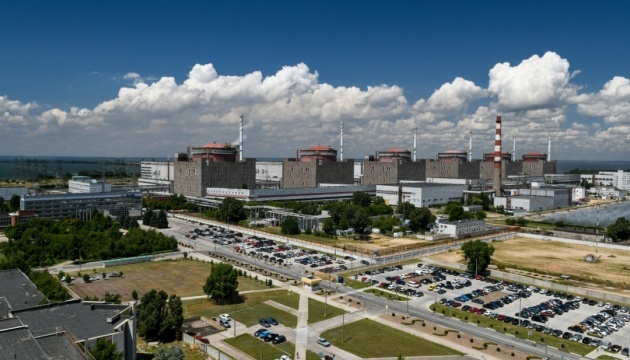
Fakes about Zaporizhzhia NPP and Russian Nuclear Blackmail
After all, the military of the occupying state have turned the nuclear power plant into a military base, and propagandists and officials openly blackmail the world with a new man-made disaster. Moscow regularly spreads fakes in the media space and accuses Ukraine of planning sabotage at the ZNPP.
Since the seizure of the nuclear power plant by the Russians, the Ukrainian authorities and the military-political leadership have been trying to attract the maximum attention of the global community to the related threats. According to intelligence, Russia has completed preparations for a terrorist attack on a power plant. The President of Ukraine Volodymyr Zelenskyy on June 22 and July 5 publicly called on world leaders to prevent the catastrophe. The head of the Main Intelligence Directorate of the Ministry of Defence Kyrylo Budanov also repeatedly reported on the mining of nuclear power plants in a series of interviews with foreign media. On the evening of July 4, the General Staff of the Armed Forces of Ukraine reported on the presence of signs of placing explosives on the roof of two power units by the occupiers. With their blow-up, the Russians will be able to simulate the consequences of the shelling and blame the Armed Forces of Ukraine for it.
Kremlin propaganda is trying to convince both Russians and foreigners that the source of nuclear danger is Ukraine. Analysis of the information space indicates that Russia is conducting a relevant psychological operation involving the controlled media, officials, diplomats, the state corporation Rosatom, and foreign agents of influence. Such as the journalist of the Iranian edition of Press TV Johnny Miller (British citizen), the publication Donbass Insider, which is run by French citizen Laurent Brayard, etc.
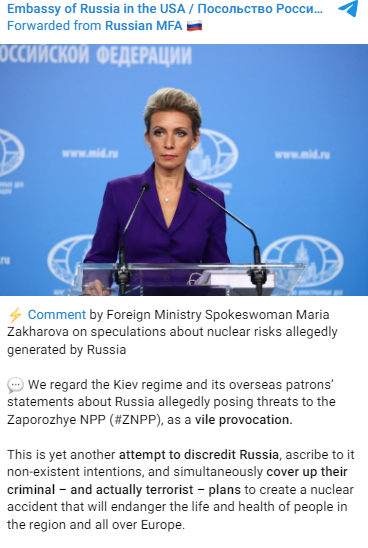
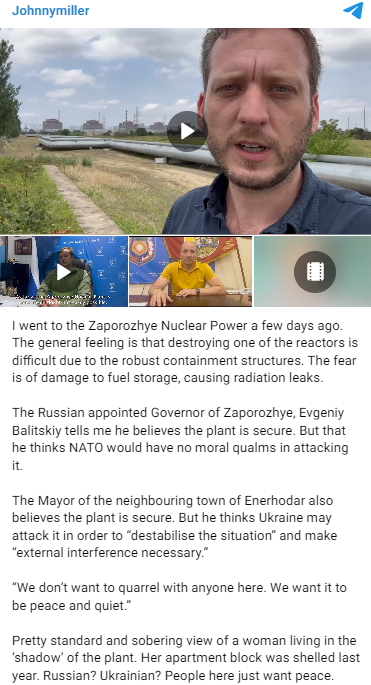
The Centre for Strategic Communication and Information Security has analyzed how Russia uses media tools to carry out nuclear blackmail and try to discredit Ukraine.
Echo of Kakhovka HPP blow-up
The blow-up of the Kakhovka HPP was the largest man-made disaster in Ukraine, which was provoked by the Russians from the beginning of the full-scale invasion. In terms of the scale of destruction and environmental damage, it can be compared to the use of nuclear weapons. This crime of the Russian army was accompanied by massive information attacks on Ukraine and unsuccessful attempts to convince at least part of foreign citizens that “it is not all that simple.”
It was after the blow-up of the Kakhovka HPP that a significant increase in mentions of the Zaporizhzhia NPP in the Russian media was observed. For two months, from May 5 to July 5, more than 10,000 publications about nuclear power plants were recorded in Russian Telegram channels alone. Before the blow-up of the dam, this figure amounted to 1,500, after — 8,500.

In addition to informing about the explosion at the HPP, Russian media and bloggers accused Ukraine of a conscious desire to complicate the situation at the Zaporizhzhia NPP because technological processes depended on water from the Kakhovka reservoir.
Peremptory accusations of Ukraine in the destruction of the Kakhovka HPP later became a watertight argument during the promotion of the statement about the preparation of a “Ukrainian provocation” at the nuclear power plant.

In particular, the former editor-in-chief of Ria Novosti Ukraine, Kirill Vyshinsky, spoke about this in on Sputnik radio, confusing kilovolts with kilowatts, on July 4.
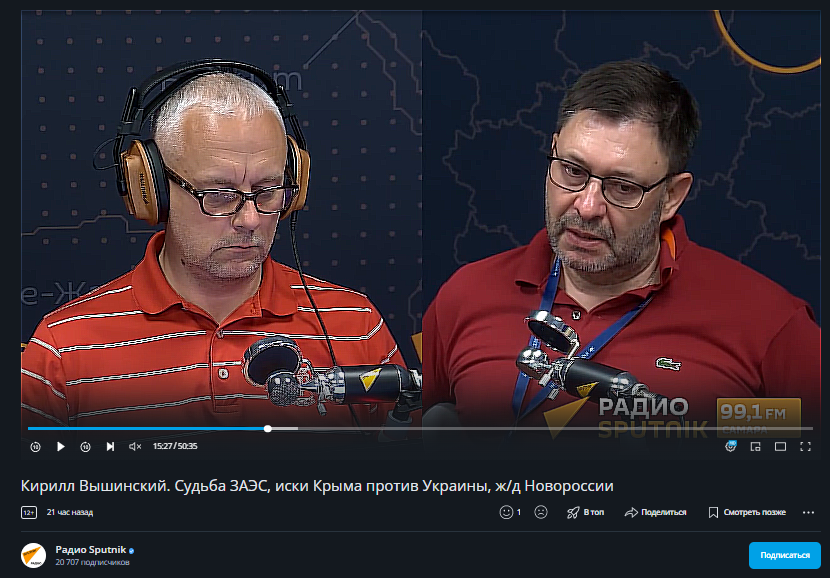
In 2018, he was arrested in Kyiv on suspicion of high treason and cooperation with Russian special services. But Vyshinsky did not stay for the verdict: in September 2019, he was extradited to Russia as part of an exchange during which Ukrainian sailors captured near the Kerch Strait, director Oleg Sentsov, journalist Roman Sushchenko, and other prisoners and civilian hostages were released.
Accusations of Ukraine and the “reflection” of the Kremlin’s desires
The campaign to accuse Ukraine of shelling the Zaporizhzhia NPP and preparing sabotage for the purpose of radiation contamination of territories has been conducted since March 2022, that is, since the seizure of the station by Russian troops. To do this, they even attacked the territory of the plant to declare the “provocation of the Armed Forces” and the use by the Ukrainian military of ammunition that “change the trajectory” and strike from the territory controlled by the Russians.
The increase in the number of reports that Ukraine is preparing an act of sabotage in the second half of June — in early July 2023 — took place against the backdrop of statements by Zelenskyy and Budanov about the ZNPP being mined by the Russians. The peak was on July 4-5, when the Russians moved directly from “refuting disinformation” to announcing the terrorist attack, promoting its scenarios, and consolidating “logical explanations” for why the blow-up of the nuclear power plant was “beneficial to Ukraine” and “definitely disadvantageous to Russia.” Promoting the point of “disadvantage” was a key element of the information “defence line” of Russia after the blow-up of the Kakhovka HPP.
Among the scenarios that propaganda spreads, the most popular is a missile strike on a repository of spent nuclear fuel or a drone attack on it. This was stated by the advisor to the head of Rosenergoatom Renat Karchaa, political scientist Sergei Markov, Z-bloggers, and anonymous Telegram channels.


Even the date was established — the night of July 5. Propagandists actively quoted the pseudo-Ukrainian channel Resident, which spread a fake that the plan of the operation was developed by the General Staff of the AFU.
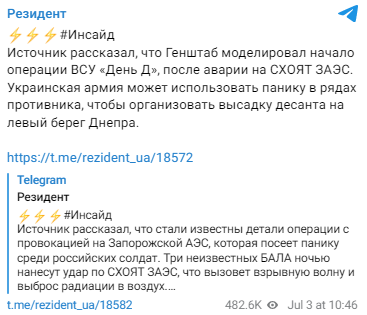
Among the motives that should guide the Ukrainian military-political leadership, the Russians cite the following:
- concealing the lack of success of the counteroffensive of the AFU;
- drawing attention to Ukraine on the eve of the NATO summit, attempts to draw the Alliance into the war against Russia;
- forcing the Russian command to withdraw troops from the territory of the plant due to radiation pollution.
Russian propaganda describes the nuclear catastrophe as Ukraine’s “last chance” to rectify the situation at the front and prevent the weakening of Western support. Given this, the level of nuclear hysteria that the Kremlin produces, on the eve of the Vilnius NATO summit on July 11-12, will only grow.
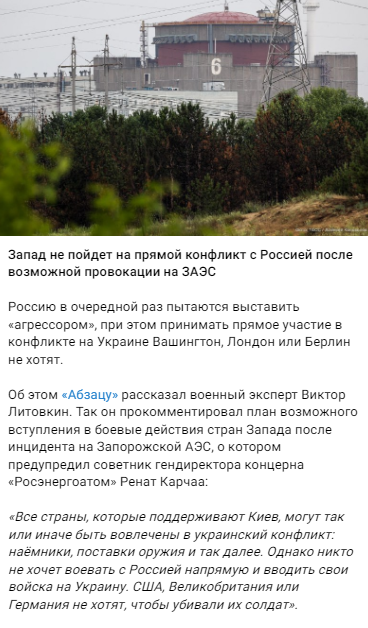
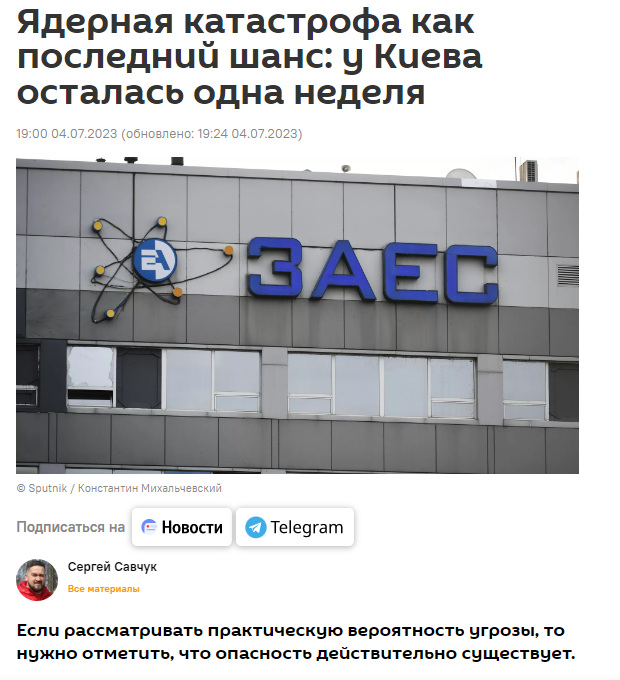
By promoting these messages, the Russians are actually revealing their own goals:
- the purpose of threats of an explosion at the ZNPP, as well as the blow-up of the Kakhovka HPP, is to stop the Ukrainian offensive in the South;
- by blatant nuclear blackmail, Russia is trying to frighten the West, weaken military support, and block Ukraine’s Atlantic integration;
- nuclear blackmail is an instrument of coercion to “peace negotiations,” considering the “territorial realities,” that is, the adamant refusal of Russia to leave the occupied territories;
- the argument about the fear of Russian generals for the health of subordinates who may be in the zone of radiation contamination, having arranged positions in the Chornobyl zone and dug trenches in the Red Forest, looks ridiculous;
- the tactics of “the scorched earth” and the destruction of Ukraine’s economic potential by polluting agricultural territories are common for the Russian military.
Search for evidence in the Ukrainian media space and manipulation of IAEA statements
Any mention in the Ukrainian media of the presence of a nuclear threat, statements by officials, Russian propaganda is trying to present as evidence of Ukraine’s preparation for provocations at the nuclear power plant. The Russians pay special attention to media figures known to the Russian audience. Excerpts from the video blog of paediatrician Yevhen Komarovskyi and another interview with Oleksii Arestovych for Dmytro Gordon were actively spread in Telegram channels and on social networks.

Moreover, propagandists “pay attention” to petitions on the website of the President of Ukraine concerning the situation at the ZNPP, as well as other security and preventive measures in the event of a nuclear threat.

The Russians portray the public actions of the Security Service of Ukraine and Energoatom aimed at restoring contacts with ZNPP employees who left the occupied territory or remain there as an attempt to “recruit saboteurs.”
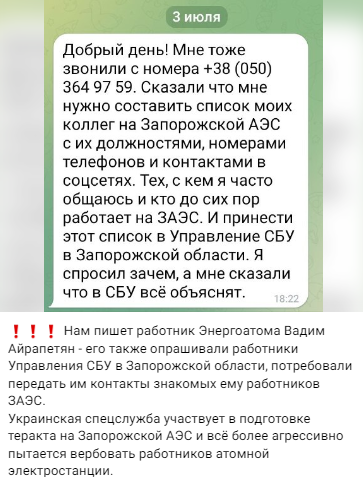
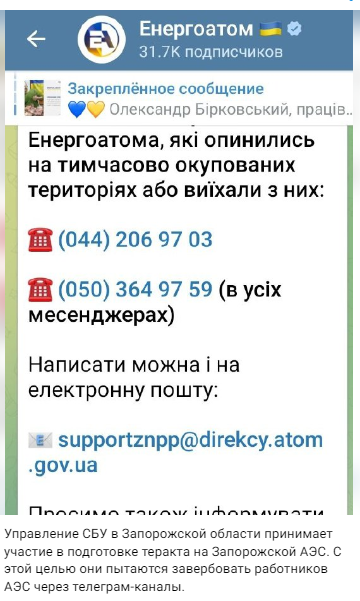
The Russian media actively reacted to the visit of the Armed Forces Command to the Rivne NPP to discuss security issues and risks associated with the situation at the ZNPP with energy sector specialists.
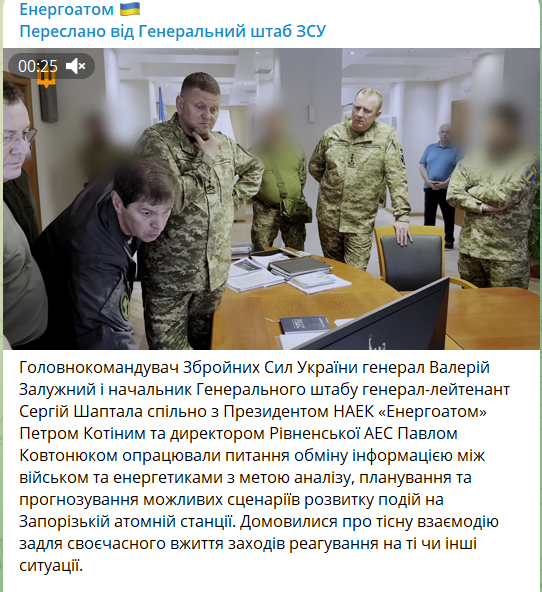
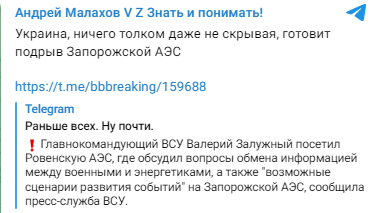
For the Kremlin propaganda, this was not only “proof” of Ukrainians preparing for sabotage in Enerhodar, but also evidence that Kyiv was blackmailing the West and frightening it with an explosion near the border with the EU.
The Russian media regularly manipulate the statements of the International Atomic Energy Agency (IAEA) and Director General Rafael Grossi. Thus, at the end of June, Russian media spread the news that the IAEA allegedly refuted Budanov’s statement about the Russians mining the ZNPP. In fact, the Agency confirmed the fact of mining the perimeter of the plant. The statement mentioned that the inspectors did not find explosives in the cooling pond. The Russian media simply “did not notice” the part concerning the mining of the perimeter, and the statement about the absence of explosives in the cooler was extrapolated to the entire object.
What are the real threats?
The Zaporizhzhia NPP is the largest nuclear power plant in Europe, and its seizure by the Russian military poses massive risks to nuclear and radiation safety in Europe and the world. The plant has not supplied electricity for the needs of Ukraine since September 11, 2022. Five of its six reactors have been switched to “cold mode,” one (fifth) is in “hot stop” mode to support the operation of the station. Since September 1, 2022, several IAEA specialists are on duty at the ZNPP, changing periodically.
There are many potential scenarios of accidents and terrorist attacks at the facility. The station has a certain level of protection from external influences, but the designers did not provide for the fact that the station may be in the zone of active hostilities.
Cooling of ZNPP reactors occurs at the expense of water in a large cooling pond, drain channel, and small splash ponds.
In the event of an explosion of the cooling pond as a result of a mine or missile strike, nuclear reactors will not be able to operate normally and safely. Damage and dehydration of small ponds can lead to heating and even ignition of spent fuel and release of radioactive substances.
If the power plant is de-energized due to the termination of external power supply and disabling of internal spare diesel stations, it will be impossible to cool the reactor core. This could lead to a serious accident, such as the one that occurred at the Fukushima-1 station in Japan in 2011.
Spent fuel is placed in dry storage after five years of cooling in the storage pond. Dry cask storage is a large container standing on an open site on the territory of the plant. It has a certain margin of safety, is able to withstand a grenade launcher shot, is fire-resistant. Its detonation, which the Russians have been actively talking about since the beginning of July, will lead to a local release of radiation.
***
In the course of the full-scale invasion, Russia has actively resorted to acts of nuclear terrorism on the territory of Ukraine: it strikes at nuclear facilities, seizes them, and uses them as military bases, holding personnel hostage. The Chornobyl Nuclear Power Plant was under the control of the invaders for more than a month. The Russians killed nine and kidnapped five employees of the station, and took 169 captured soldiers of the National Guard, who guarded the facility, out of Ukraine. In addition, the Russians damaged and stole hundreds of computers, software, 1,500 dosimetric devices, and firefighting equipment. This caused damage to the security system of the Chornobyl NPP, the amount of damage exceeds USD 135 million.
During the battles for Kharkiv in spring and summer 2022, Russian troops targeted the Neutron Source nuclear facility on the territory of the Kharkiv Institute of Physics and Technology several times. The installation itself was hit, with 37 fuel cells loaded. Its damage and destruction of nuclear material repositories could lead to a large-scale environmental disaster.
Today, Russia is threatening the world with a terrorist attack on Europe’s largest nuclear power plant, shifting responsibility to Ukraine in advance. The Kremlin’s behaviour once again proves that the issue of the future denuclearization of Russia should become a key item on the agenda of the entire civilized world.
Centre for Strategic Communication and Information Security

